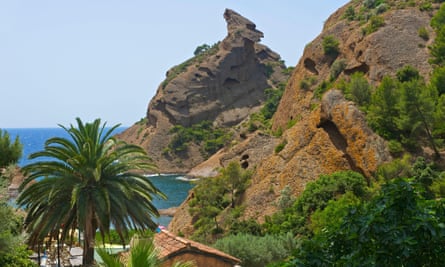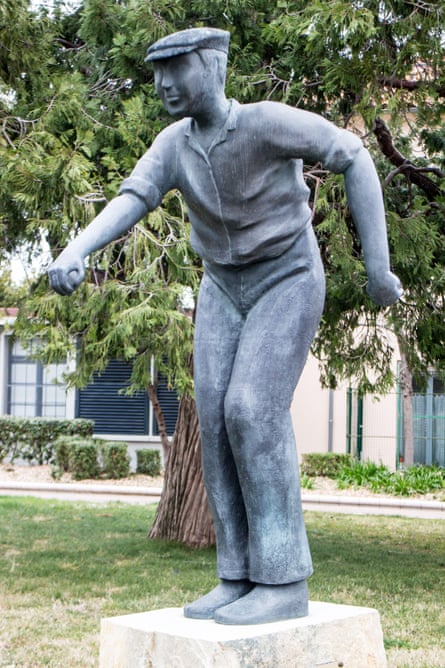So impressive were the shipyards at La Ciotat, halfway between Marseille and Toulon, that French emperors, dignitaries and scientists would flock there to witness the launch of an ocean liner. The swell overflowed the port, flooding cafes and carrying diners and motorcars out to sea.
It all seemed calm when I visited this summer. Shipbuilding ended in La Ciotat in 1987 but the yard was turned into a hub for refitting luxury ships and superyachts, keeping a huge workforce active while the town turned its attention to tourism. I wander along the seafront past a giant 3D #ILoveLaCiotat sign, brightly painted pointu boats, a ferry going to Île Verte, barrels of fishing nets, some great-looking restaurants and a restored hammerhead crane.
Le Port Vieux (to distinguish it from Marseille’s Vieux-Port) feels like many other Mediterranean ports except the view is astonishing: a panoramic skyline of soaring masts, cranes, riveted girders, one of the largest boatlifts in the world and a titan-white gantry overhanging the port. There are some great sandy beaches along the north-east of the bay but the big attraction of La Ciotat lies in its busy, unpretentious, industrial elegance.
The shipyard’s massive armaments building has been redeveloped, maintaining its heavy industrial integrity but now with a pedestrian walkway and restaurant above a row of nautical outfitters, a bookshop and Les Toiles du Large, which turns old sails into bags and accessories. People bring in their old canvas sails, they can choose a bag to be made from them and the rest is recycled into duffle bags, tote bags, backpacks, beanbags and deckchairs in the open workshop at the back of the shop, complete with the original stitched seams and navigational scars of a previous life on the seas.

I walk behind the old shipyard towards the Parc du Mugel and the Mugel Calanques – rocky coves with turquoise water and pebble beaches, a botanical gardens of parasol pines, chestnut trees, wild flowers and bamboo. Further round the ochre-coloured puddingstone coast and accessible via 87 steps down to the beach is the Calanque de Figuerolles, where there’s a tiny hotel, as well as a restaurant, Chez Tania. It’s always packed in the summer but in autumn, you can have the beach, the eroded crags of the Eagle’s beak, the Dog’s head and Lion’s islet, all within the Calanques national park, almost to yourself.
Auguste and Louis Lumière perfected autochrome (photography using colour plates) along the bay of La Ciotat, while staying at their summer house, now known as the Palais Lumière. It was there, in September 1895, that they demonstrated the first cinematograph films, among them Arrival of a Train at La Ciotat Station. After a showing in Paris (where, legend has it, the panicked audience tried to flee, believing the train was about to crush them), the 50-second film appeared at La Ciotat’s Eden theatre. Refurbished in 2013 when Marseille was European Capital of Culture, the Eden is the world’s oldest surviving cinema with screenings every day and tours on Wednesday and Saturday afternoons.
after newsletter promotion

Photograph: Roland Bouvier/Alamy
The unsung cradle of cinema, La Ciotat was also the birthplace of France’s unofficial national sport: pétanque. Enzo Balbi, president of the Jules Le Noir pétanque club, greets me under the shade of some plane trees on a gravel boules court a few blocks from the sea.
“This is where it all started,” he tells me. “Local shopkeeper Jules Hugues (known as Le Noir), suffered from rheumatism; he was the only one allowed to sit in a chair to throw his boules.”
The original game in the south, Jeu Provençal, involved a three-step runup, but Balbi says: “They decided that if Jules was playing, the others weren’t allowed to move their feet either.”
The name pétanque comes from Pè tancat – foot fixed – in the local dialect. “The first tournament was held on this court in 1910,” says Balbi, “and today there are federations in 80 countries.
“Players from all over the world come for Le Mondial la Marseillaise [the pétanque championships in Marseille] and love to visit us here as this is where it all began. Everyone is welcome to play on the courts as long as they bring their own boules.”
I quickly discover that I am useless at the game so head back into the pedestrianised old town. The art-deco Cafe de l’Horloge has a paperback on every table and a wall of secondhand books for 50 cents each. It’s great for people-watching, croissants, bagels and lunchtime soup. Across the way, Rue des Frères Blanchard has Lait Trais’or de Marie, a cheese shop and creamery, the Lebanese cafe Chez Sophie, and Frérots specialising in natural wines. A block away is Chymós the organic grocers, with lots of ice-cream parlours and sunny cafes in between. It is a 17th-century town centre renovated into an organic-minded, picturesque resort.
Stay at one of the characterful properties in the old town or overlooking the sea managed by La Maison de Famille. Studios and apartments start at €95 a night.
La Ciotat-Ceyreste station is 32 minutes by train from Marseille St-Charles (€9 single) and 26 minutes from Toulon (€7.60 single). La Ciotat centre is a 15-minute bus ride from the station (€0.90 single).

